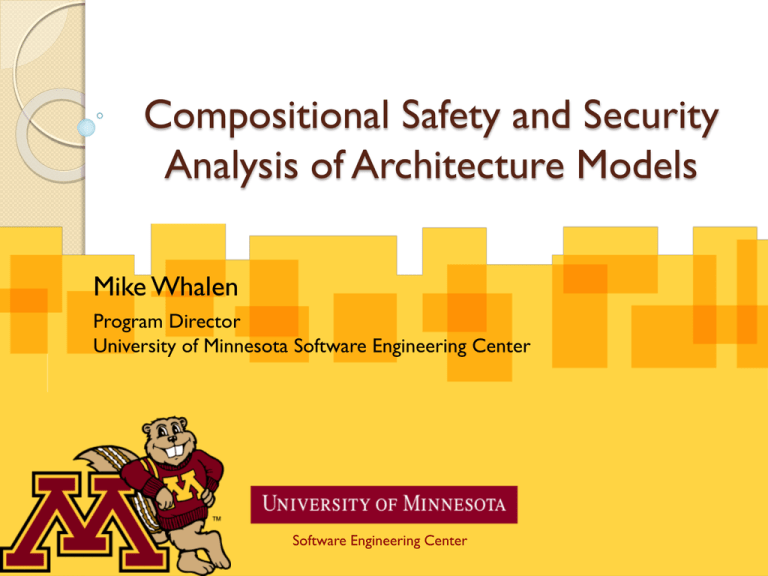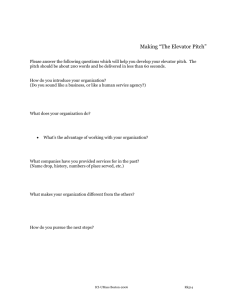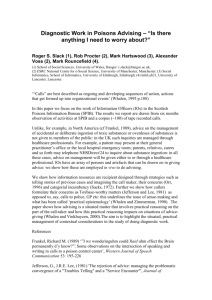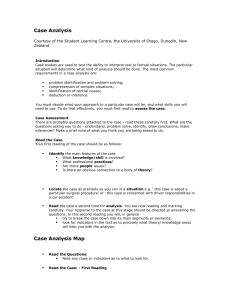
Compositional Safety and Security
Analysis of Architecture Models
Mike Whalen
Program Director
University of Minnesota Software Engineering Center
Software Engineering Center
Acknowledgements
Rockwell Collins (Darren Cofer, Andrew
Gacek, Steven Miller, Lucas Wagner)
UPenn: (Insup Lee, Oleg Sokolsky)
UMN (Mats P. E. Heimdahl)
CMU SEI (Peter Feiler)
February, 2012
IFIP 2012: Mike Whalen
2
Main Messages
We need a variety of reasoning approaches and
partitioning methods for system-level
requirements and analysis
Your How is My What: requirements vs.
design is a often matter of perspective
Requirements hierarchies often follow system
and software architectures.
February, 2012
IFIP 2012: Mike Whalen
3
Component Level Formal Analysis Efforts
February, 2012
IFIP 2012: Mike Whalen
4
February, 2012
IFIP 2012: Mike Whalen
5
An Overview of AADL V2
Mismatched Assumptions
System
Under
Control
Operator Error
Lag, proximity
Hardware
Engineer
Compute
Platform
Physical Plant
Characteristics
Lag, proximity
Control Engineer
Data Stream
Characteristics
ETE Latency (F16)
State delta (NASA)
Runtime
Architecture
Embedded SW
System Engineer
Measurement Units
Ariane 4/5
Air Canada
Control
System
Application
Software
Application Developer
System User
System Engineer
Concurrency
Communication
ITunes crashes on dual-cores
Distribution & Redundancy
Virtualization of HW
(ARPA-Net split)
Slide from: An Overview of AADL v2 by Peter Feiler, 2010
© 2010 Carnegie Mellon University
6
Vision
System design & verification through pattern
application and compositional reasoning
SENSOR 1
VOTE
MULTIPLE
DATA
SENSOR
SENSOR2
SENSOR 3
ARCHITECTURE
MODEL
FAIL-SILENT
NODE FROM
REPLICAS
VERIFIED
INTEGRITY
COMPOSITIONAL PROOF OF CORRECTNESS
(ASSUME – GUARANTEE)
VERIFICATION
REUSE
VERIFIED
AVAILABILITY
COMPUTING
RESOURCE A
COMPUTING
RESOURCE
COMPUTING
RESOURCE B
ABSTRACTION
LRU
SAFETY, BEHAVIORAL,
PERFORMANCE PROPERTIES
COMPOSITION
© Copyright 2011 Rockwell Collins, Inc.
All rights reserved.
February, 2012
IFIP 2012: Mike Whalen
7
Complexity-reducing design patterns
• Capture best solutions to architectural design
problems
• Reuse of formally verified solutions
2
• Increase level of design abstraction
Approach
INSTANTIATE ARCH
PATTERNS
& CHECK
CONSTRAINTS
ARCH
PATTERN
MODELS
ANNOTATE
& VERIFY
MODELS
COMPONENT
MODELS
PATTERN &
COMP SPEC
LIBRARY
SYSTEM MODELING
ENVIRONMENT
SYSTEM
MODEL
(AADL)
COMPONENT
LIBRARY
SPECIFICATION
COMPOSITIONAL
REASONING &
ANALYSIS
SYSTEM DEVELOPMENT
System architecture modeling
• Apply formal specification and analysis tools to
system-level design
• Separate component specification and
implementation
1
• Automated model translation
© Copyright 2011 Rockwell Collins, Inc.
All rights reserved.
SYSTEM
IMPLEMENTATION
AUTO
GENERATE
Design Flow
FOUNDRY
Compositional verification
3
• Reason about system behavior based on
contracts and system design model structure
• Compositional approach scales to large
software systems
February, 2012
IFIP 2012: Mike Whalen
8
Complexity-Reducing
Architectural Design Patterns
Design pattern = model transformation
◦ p : M M (partial function)
◦ Applied to system models
Reuse of verification is key
◦ Not software reuse
◦ Guaranteed behaviors associated with
patterns (and components)
Reduce/manage system complexity
◦ Separation of concerns
◦ System logic vs. application logic (e.g., fault tolerance)
◦ Process complexity vs. design complexity
Encapsulate & standardize good solutions
◦ Raise level of abstraction
◦ Codify best practices
© Copyright 2011 Rockwell Collins, Inc.
All rights reserved.
February, 2012
IFIP 2012: Mike Whalen
9
System Design Through Pattern Application
Active Standby Pattern
Replicate
Leader Selection
Replicate
PALS
Final
System
Flight
Guidance
Flight
Control
System Hierarchy
Avionics
System
Initial
System
Pattern Application
© Copyright 2011 Rockwell Collins, Inc.
All rights reserved.
February, 2012
IFIP 2012: Mike Whalen
10
System verification
SPECIFICATION
SYSTEM DEVELOPMENT
INSTANTIATE
ARCHITECTURAL
PATTERNS
ARCH
PATTERN
MODELS
ANNOTATE
& VERIFY
MODELS
COMPONENT
MODELS
FOUNDRY
PATTERN &
COMP SPEC
LIBRARY
SYSTEM
MODELING
ENVIRONMENT
COMPONENT
LIBRARY
Reusable Verification:
Proof of component and pattern
requirements (guarantees) and
specification of context
(assumptions)
© Copyright 2011 Rockwell Collins, Inc.
All rights reserved.
SYSTEM
MODEL
AUTO
GENERATE
SYSTEM
IMPLEMENTATION
COMPOSITIONAL
REASONING &
ANALYSIS
Instantiation:
Check structural constraints,
Embed assumptions &
guarantees in system model
February, 2012
Compositional Verification:
System properties are verified
by model checking using
component & pattern
contracts
IFIP 2012: Mike Whalen
11
Hierarchical reasoning about
systems
Avionics system requirement
Avionics
System
Under single-fault assumption,
GC output transient response is
bounded in time and magnitude
Relies upon
ADS_L
ADS_R
FGS_L
FGS_R
FCS
…
Autopilot
…
◦ Accuracy of air data sensors
◦ Control commands from FCS
Mode of FGS
FGS control law behavior
Failover behavior between FGS
systems
….
◦ Response of Actuators
System
Modes
Control
Laws
Co-ord
◦ Timing/Lag/Latency of
Communications
February, 2012
IFIP 2012: Mike Whalen
12
Compositional Reasoning for Active
Standby
Want to prove a transient
response property
◦
◦
◦
Even when one FGS fails and the
other assumes control
The sensed aircraft pitch from the
air data system is within some
absolute bound and doesn’t change
too quickly
CSA
AP : Autopilot_System
GC_L
FGSLtoAP
FGSLtoFDL
FD_L
GC_R
FGSRtoAP
GC
ADLtoFGSL
FGS_R : Flight_Guidance_System
AD
FM_L
NAV_L
AHLtoFGSL
AHRtoFGSR
AH
VNAV
FM_R
LSD
NAVRtoFGSR
NAV
NAVLtoFGSL
AH_R
FMRtoFGSR
VNAV
FGSRtoFGSL
LSI
AD_R
LSI
AH
FMLtoFGSL
ADRtoFGSR
AD
FGSLtoFGSR
LSD
AH_L
FD_R
GC
FGS_L : Flight_Guidance_System
AD_L
FGSRtoFDR
NAV_R
NAV
FCI
FCI
FCItoFGSL
FCItoFGSR
FCI
FCI : Flight_Crew_Interface
THROT_R
THROTL2FCI
THROTR2FCI
THROT_L
YOKEL2FCI
YOKE_L
YOKE_R
YOKER2FCI
When a FGS is active, it will generate
an acceptable pitch rate
As well as facts provided by
pattern application
◦
Flight_Control_System
AP2CSA
Flight_Control_System_Impl
The discrepancy in sensed pitch
between left and right side sensors is
bounded.
and guarantees provided by
components
◦
CSA
The autopilot will not cause a sharp
change in pitch of aircraft.
Given assumptions about the
environment
◦
ibd [SysML Internal Block] Flight_Control_System_Impl [Flight_Control_System]
Leader selection: at least one FGS
will always be active (modulo one
“failover” step)
THROT_L
YOKE_L
YOKE_R
THROT_R
transient_response_1 : assert true ->
abs(CSA.CSA_Pitch_Delta) < CSA_MAX_PITCH_DELTA ;
transient_response_2 : assert true ->
abs(CSA.CSA_Pitch_Delta - prev(CSA.CSA_Pitch_Delta, 0.0))
< CSA_MAX_PITCH_DELTA_STEP ;
February, 2012
IFIP 2012: Mike Whalen
13
Avionics system requirement
Under single-fault assumption,
GC output transient response is
bounded in time and magnitude
System
Behavior
Leader
Selection
Relies upon
◦ Guarantees provided by
patterns and components
◦ Structural properties of
model
◦ Resource allocation feasibility
◦ Probabilistic system-level
failure characteristics
Principled mechanism for
“passing the buck”
© Copyright 2011 Rockwell Collins, Inc.
All rights reserved.
synchronous
communication
leader transition
managed on
failure
one node
operational
PALS
Replication
Structure
timing
constraints
not
co-located
ASSUMPTIONS
GUARANTEES
Hierarchical reasoning between
analysis domains.
Flight Control
Platform
Resource
October 2012 AADL Meeting
Probabilistic
RT sched
& latency
Mike Whalen
Error
model
14
Contracts
Derived from Property
Specification Language
(PSL) formalism
◦ IEEE standard
◦ In wide use for hardware
verification
Assume / Guarantee style
specification
◦ Assumptions: “Under
these conditions”
◦ Promises (Guarantees):
“…the system will do X”
Local definitions can be
created to simplify
properties
© Copyright 2011 Rockwell Collins, Inc.
All rights reserved.
Contract:
fun abs(x: real) : real = if (x > 0) then x else -x ;
const
const
const
const
ADS_MAX_PITCH_DELTA: real
FCS_MAX_PITCH_SIDE_DELTA:
CSA_MAX_PITCH_DELTA: real
CSA_MAX_PITCH_DELTA_STEP:
= 3.0 ;
real = 2.0 ;
= 5.0 ;
real = 5.0 ;
property AD_L_Pitch_Step_Delta_Valid =
true ->
abs(AD_L.pitch.val - prev(AD_L.pitch.val, 0.0)) < ADS_MAX_PITCH_DELTA ;
property AD_R_Pitch_Step_Delta_Valid =
true ->
abs(AD_R.pitch.val - prev(AD_R.pitch.val, 0.0)) < ADS_MAX_PITCH_DELTA ;
property Pitch_lr_ok =
abs(AD_L.pitch.val - AD_R.pitch.val) < FCS_MAX_PITCH_SIDE_DELTA ;
property some_fgs_active =
(FD_L.mds.active or FD_R.mds.active) ;
active_assumption: assume some_fgs_active ;
transient_assumption :
assume AD_L_Pitch_Step_Delta_Valid and
AD_R_Pitch_Step_Delta_Valid and Pitch_lr_ok ;
transient_response_1 :
assert true -> abs(CSA.CSA_Pitch_Delta) < CSA_MAX_PITCH_DELTA ;
transient_response_2 :
assert true ->
abs(CSA.CSA_Pitch_Delta - prev(CSA.CSA_Pitch_Delta, 0.0)) <
CSA_MAX_PITCH_DELTA_STEP ;
February, 2012
IFIP 2012: Mike Whalen
15
Reasoning about contracts
Notionally: It is always the case that if the
component assumption is true, then the component
will ensure that the guarantee is true.
◦ G(A P);
An assumption violation in the past may prevent
component from satisfying current guarantee, so
we need to assert that the assumptions are true
up to the current step:
◦ G(H(A) P) ;
September, 2012
LCCC 2012: Mike Whalen
16
Systems of Contracts
Architectures are hierarchically composed
in layers.
ibd [SysML Internal Block] Flight_Control_System_Impl [Flight_Control_System]
◦ Visually: a box and
line diagram
◦ Formally you can
view a layer as a
system S:
S = (A, P, C)
C is a finite set of
component contracts
C: ℙ (A x P)
CSA
Flight_Control_System
AP2CSA
Flight_Control_System_Impl
CSA
AP : Autopilot_System
GC_L
FGSLtoAP
FGSLtoFDL
FD_L
GC_R
FGSRtoAP
GC
ADLtoFGSL
FGS_R : Flight_Guidance_System
AD
AH_L
FM_L
NAV_L
AHRtoFGSR
AH
VNAV
LSI
FMRtoFGSR
VNAV
FGSRtoFGSL
AH_R
FM_R
LSD
NAVRtoFGSR
NAV
NAVLtoFGSL
AD_R
LSI
AH
FMLtoFGSL
ADRtoFGSR
AD
FGSLtoFGSR
LSD
AHLtoFGSL
FD_R
GC
FGS_L : Flight_Guidance_System
AD_L
FGSRtoFDR
NAV_R
NAV
FCI
FCI
FCItoFGSL
FCItoFGSR
FCI
FCI : Flight_Crew_Interface
THROT_R
THROTL2FCI
YOKEL2FCI
THROT_L
YOKE_L
YOKE_L
February, 2012
THROTR2FCI
THROT_L
YOKE_R
YOKER2FCI
YOKE_R
IFIP 2012: Mike Whalen
THROT_R
17
Reasoning about Contracts
Given the set of component contracts:
Γ = { G(H(Ac) Pc) | c ∈ C }
Architecture adds a set of obligations that
tie the system assumption to the
component assumptions
This process can be repeated for any
number of abstraction levels
September, 2012
LCCC 2012: Mike Whalen
18
Composition Formulation
Suppose we have
Then if for all q ∈ Q
◦ Γ G((Z(H(Θq)) ^ Δq) q)
Then:
G(q) for all q ∈ Q
[Adapted from McMillan]
September, 2012
LCCC 2012: Mike Whalen
19
A concrete example
Order of data flow through
system components is
computed by reasoning engine
◦ {System inputs}
{FGS_L, FGS_R}
ibd [SysML Internal Block] Flight_Control_System_Impl [Flight_Control_System]
CSA
Flight_Control_System
AP2CSA
Flight_Control_System_Impl
CSA
AP : Autopilot_System
GC_L
FGSLtoAP
FGSLtoFDL
FD_L
GC_R
FGSRtoAP
GC
◦ {FGS_L, FGS_R} {AP}
◦ {AP} {System outputs}
Based on flow, we establish
four proof obligations
ADLtoFGSL
AH_L
FM_L
NAV_L
◦ System assumptions +
FGS_L guarantees +
FGS_R guarantees
AP assumptions
AHRtoFGSR
AH
VNAV
FMRtoFGSR
VNAV
FGSRtoFGSL
LSI
AH_R
FM_R
LSD
NAVRtoFGSR
NAV
NAVLtoFGSL
AD_R
LSI
AH
FMLtoFGSL
ADRtoFGSR
AD
FGSLtoFGSR
LSD
NAV_R
NAV
FCI
FCI
◦ System assumptions
FGS_L assumptions
◦ System assumptions
FGS_R assumptions
FGS_R : Flight_Guidance_System
AD
AHLtoFGSL
FD_R
GC
FGS_L : Flight_Guidance_System
AD_L
FGSRtoFDR
FCItoFGSL
FCItoFGSR
FCI
FCI : Flight_Crew_Interface
THROT_R
THROTL2FCI
YOKEL2FCI
THROT_L
THROTR2FCI
THROT_L
YOKE_L
YOKE_R
YOKE_L
YOKER2FCI
YOKE_R
THROT_R
◦ System assumptions + {FGS_L, FGS_R, AP} guarantees System guarantees
System can also handle circular flows, but user has to choose where to break cycle
February, 2012
IFIP 2012: Mike Whalen
20
Architecture of Generic Infusion
Pump
GPCA Pump
Pump Hardware
Flow Rate
Detector
Door
Pump
Position
Humidity
Temp
Air
Pressure
Battery
Power
Supply
Air In Line
Detector
Pump
Motor
Buzzer
Pump Controller
Software
GPCA = Generic Patient-Controlled Analgesia
Product Family architecture
Infusion
Command
GPCA Pump Example
Property of Interest:
◦ If a “Pump Stop” command is received, then
within 1 second, measured flow rate shall be
zero.
We will prove this property
compositionally based on the architecture
of the Pump subsystem.
Proof of GPCA Pump
GPCA Pump
Pump Hardware
Flow Rate
Detector
Pump
Position
…
Humidity
Temp
…
Battery
Power
Supply
…
Pump
Motor
Buzzer
Assertion: When a “Pump Stop” infusion command is
received, then within 1 second, measured flow rate
shall be zero.
Pump Controller
Software
Infusion
Command
Proof of Reciprocating Pump
GPCA Pump
Reciprocating Pump Hardware
Flow Rate
Detector
Door
Humidity
Temp
Battery
Power
Supply
Pump
Motor
Buzzer
if pump is in no
ambient flow position
and pump motor is off,
then flow rate will be
zero within 200 ms
Assertion: When
powered on, pump
cycles between ambient
and no-ambient flow
states every 300 ms.
Pump Controller
Software
When pump stop
command occurs,
pump motor will be
switched off when
pump motor position
reaches no-ambient
flow state.
Assertion: When a “Pump Stop” infusion command is received, then
within 1 second, measured flow rate shall be zero.
Proof of Rotary Pump
GPCA Pump
Rotary Pump Hardware
Flow Rate
Detector
Door
Humidity
Temp
Battery
Power
Supply
Pump
Motor
Buzzer
if pump is in no
ambient flow position
and pump motor is off,
then flow rate will be
zero within 400 ms
Pump Controller
Software
When pump stop
command occurs,
pump motor will be
immediately switched
off.
Assertion: When a “Pump Stop” infusion command is received, then
within 1 second, measured flow rate shall be zero.
ARCHITECTURE AND
REQUIREMENTS
February, 2012
IFIP 2012: Mike Whalen
26
Requirements or Design Information?
1.
The patient shall never be infused with a single air
bubble more than 5ml volume.
2.
When a single air bubble more than 5ml volume is
detected, the system shall stop infusion within 0.01
seconds.
3.
When a single air bubble more than 5ml volume is
detected, the system shall issue an air-embolism
command.
4.
When air-embolism command is true, the system
shall stop infusion.
5.
When air-embolism command is received, the
system shall stop piston movement within 0.1
second.
9/25/2012
Mike Whalen - TwinPeaks 2012
27
A: Both
1.
The patient shall never be infused
with a single air bubble more than
5ml volume.
3. When a single air bubble more than
5ml volume is detected, the system
shall issue an air-embolism command.
PATIENT THERAPY SYSTEM
INFUSION SYSTEM
DRUG
DELIVERY
HARDWARE
AIR BUBBLE
SENSOR
4.
PUMP SYSTEM
PUMP
HARDWARE
PUMP
CONTROLLER
5.
2.
When a single air bubble more
than 5ml volume is detected, the
system shall stop infusion within
0.01 seconds.
When air-embolism
command is true, the
system shall stop infusion.
When air-embolism command is
received, the system shall stop
piston movement within 0.1 seconds
9/25/2012
Mike Whalen - TwinPeaks 2012
28
9/25/2012
Mike Whalen - TwinPeaks 2012
29
Your How is My What
Systems are hierarchically organized
Requirements vs. architectural design must be a
matter of perspective
Need better support for N-level
decompositions for requirements and
architectural design
◦ Reference model support
How do elements “flow” between world, machine, and
specification as we decompose systems?
◦ Certification standard support (DO-178B/C)
Currently: two levels of decomposition: “high” and “low”
9/25/2012
Mike Whalen - TwinPeaks 2012
30
Twin Peaks
9/25/2012
Mike Whalen - TwinPeaks 2012
31
Often, Architecture Comes First
Candidate architectures from previous
systems
◦ Designer familiarity
◦ Cost amortization
Program families
Certification or criticality requirements
Architectural choices often restrict set
of achievable system requirements.
9/25/2012
Mike Whalen - TwinPeaks 2012
32
Flow is Bi-directional
9/25/2012
Mike Whalen - TwinPeaks 2012
33
Requirements Validation and
Verification
Given hierarchical systems, where are the most
serious problems with requirements?
◦ At the component level?
◦ At the top-level?
◦ Somewhere in the middle?
A hypothesis:
◦ The most problematic are the layers in the middle
◦ Errors in decomposing system requirements become
integration problems.
These are requirements to be both verified and
validated.
9/25/2012
Mike Whalen - TwinPeaks 2012
34
STRUCTURAL
PROPERTIES
February, 2012
IFIP 2012: Mike Whalen
35
Structural Properties
Often, we are interested in properties
about a model structure
◦ Given the processor resources, is the system
schedulable?
◦ Is my software correctly distributed across
different physical resources?
◦ Are my end-to-end timing assumptions met?
Often these involve checking the mapping
between the software and the hardware.
February, 2012
IFIP 2012: Mike Whalen
36
Structural Properties
Software + HW platform
◦ Process, thread, processors, bus
Ex: PALS vertical contract
◦ PALS timing constraints on platform
◦ Check AADL structural properties
Guarantees
◦ Sync logic executes at PALS_Period
◦ Synchronous_Communication
=> “One_Step_Delay”
Software
Assumptions (about platform)
◦ Causality constraint:
Min(Output time) ≥ 2ε – μmin
◦ PALS period constraint:
Max(Output time) ≤ T - μmax - 2ε
February, 2012
37
Platform
IFIP 2012: Mike Whalen
PALS assumptions in AADL
Ti
± )
(
Ti+1
(
± )
Clock_Jitter
Period
Deadline
Compute_Execution_Time
Output_Time
Output
message
Latency
Dispatch_Offset (if imposed)
Dispatch_Jitter (if describing max scheduling delay)
(
± )
(
Thread execution
Earliest output message
± )
Period
Thread execution
Latest output
message
Latest period start
Latest period start
on other node
Causality Constraint
Earliest period start
on other node
Deadline
Min(Output_Time)
Min(Latency)
Input
message
available
Max(Latency)
Max(Output_Time)
PALS Period Constraint
February, 2012
38
IFIP 2012: Mike Whalen
(
± )
Structural property checks
Contract
◦ Platform model satisfies
PALS assumptions
Attached at pattern
instantiation
◦ Model-independent
◦ Assumptions
◦ Pre/post-conditions
Lute theorems
◦ Based on REAL
◦ Eclipse plug-in
◦ Structural properties in
AADL model
PALS_Threads := {s in Thread_Set | Property_Exists(s,
"PALS_Properties::PALS_Id")};
PALS_Period(t) := Property(t, "PALS_Properties::PALS_Period");
PALS_Id(t) := Property(t, "PALS_Properties::PALS_Id");
PALS_Group(t) := {s in PALS_Threads | PALS_Id(t) = PALS_Id(s)};
Max_Thread_Jitter(Threads) :=
Max({Property(p, "Clock_Jitter") for p in Processor_Set |
Cardinal({t in Threads | Is_Bound_To(t, p)}) > 0});
Connections_Among(Set) :=
{c in Connection_Set | Member(Owner(Source(c)), Set) and
Member(Owner(Destination(c)), Set)};
theorem PALS_Period_is_Period
foreach s in PALS_Threads do
check Property_Exists(s, "Period") and
PALS_Period(s) = Property(s, "Period");
end;
theorem PALS_Causality
foreach s in PALS_Threads do
PALS_Group := PALS_Group(s);
Clock_Jitter := Max_Thread_Jitter(PALS_Group);
Min_Latency := Min({Lower(Property(c, "Latency")) for
c in Connections_Among(PALS_Group)});
Output_Delay := {Property(t, "Output_Delay") for t in PALS_Group};
check (if 2 * Clock_Jitter > Min_Latency then
Min(Output_Delay) > 2 * Clock_Jitter - Min_Latency
else
true);
end;
February, 2012
39
IFIP 2012: Mike Whalen
Tool Chain
SysML-AADL translation
Enterprise
Architect
SysML
OSATE:
AADL modeling
EDICT:
Architectural
patterns
AADL
Lute:
Structural
verification
Eclipse
AGREE:
Compositional behavior
verification
Lustre
KIND
February, 2012
40
IFIP 2012: Mike Whalen
Research Challenges
February, 2012
IFIP 2012: Mike Whalen
41
Structural and Behavioral Properties
Structural (Non-functional) Properties:
Analyze conformance, optimization
properties for hardware resources and
model structure.
Assertion: My system is schedulable
using Rate Monotonic Scheduling.
Theorem RMA
foreach e in Processor_Set do
Proc_Set(e) := { x in Process_Set |
Is_Bound_To(x, e) } ;
Threads := { x in Thread_Set |
Is_Subcomponent_Of(x, Proc_Set) }
check (sum
(get_property_value (Threads
“RTOS_properties::Utilization”)) <=
(Cardinal (Threads) *
(2 ** (1 / Cardinal (Threads))) -1 ) ) ;
End RMA ;
Checkable with Lute
Behavioral (functional) Properties:
Analyze system behavior. Behavioral
properties may use structural properties.
Assertion: If a “Pump Stop” command is
received, then within 1 second the
measured flow rate shall be zero.
PSL_contract
property no_flow_after_stop :
after
(not (infusion_control_in.Pump_On))
(exists
flow_rate_detector_out.Rate = 0
within
STEPS_PER_SECOND *1) ;
assert (no_flow_after_stop) ;
end PSL_contract;
Checkable with AGREE
Are these the “right” logics?
Simpler logics have benefits
◦ Primary benefit: much simpler to analyze
◦ AADL error annex is (mostly) propositional
Makes analysis simpler
Supports useful categorization of errors
◦ Datalog-style logics support “timeless” analysis
The Lute checker is essentially a datalog interpreter
More complicated logics are necessary for certain
properties
◦ Richer types (e.g., algebraic types for XML messages)
◦ Quantification
February, 2012
IFIP 2012: Mike Whalen
43
Dealing with Time
Pure synchrony or asynchrony
Uniform discrete time
MOST ACCURATE
SIMPLEST
◦ Choose fixed time quantum between steps
◦ This quantum need not be the same between
layers
◦ Adjust process behavior and requirements with
clocks.
Non-uniform discrete time
◦ Calendar/Timeout automata advance system to
next interesting instant
Dense time
February, 2012
IFIP 2012: Mike Whalen
44
Scaling
What do you do when
systems and subcomponents
have hundreds of
requirements?
◦ FGS mode logic: 280
requirements
◦ DWM: >600 requirements
Need to create automated
slicing techniques for
predicates rather than code.
◦ Perhaps this will be in the form of
counterexample-guided
refinement
Assigning blame
Counterexamples are often
hard to understand for big
models
It is much worse (in my
experience) for propertybased models
Given a counterexample,
can you automatically assign
blame to one or more
subcomponents?
Given a “blamed” component,
can you automatically open
the black box to strengthen
the component guarantee?
Signal
Step...
0
AD_L.pitch.val
-0.91
AD_L.pitch.valid
FALSE
AD_R.pitch.val
0.83
AD_R.pitch.valid
TRUE
AP.CSA.csa_pitch_delta
0.00
AP.GC_L.cmds.pitch_delta
0.00
AP.GC_L.mds.active
TRUE
AP.GC_R.cmds.pitch_delta
0.00
AP.GC_R.mds.active
TRUE
Assumptions for AP
TRUE
Assumptions for FCI
TRUE
Assumptions for FGS_L
TRUE
Assumptions for FGS_R
TRUE
FGS_L.GC.cmds.pitch_delta
-4.91
FGS_L.GC.mds.active
FALSE
FGS_L.LSO.leader
2
FGS_L.LSO.valid
FALSE
FGS_R.GC.cmds.pitch_delta
0.83
FGS_R.GC.mds.active
TRUE
FGS_R.LSO.leader
0
FGS_R.LSO.valid
TRUE
leader_pitch_delta
0.00
System level guarantees
TRUE
February, 2012
1
-1.83
TRUE
-0.09
FALSE
0.13
-4.91
FALSE
0.83
TRUE
TRUE
TRUE
TRUE
TRUE
-4.65
FALSE
2
TRUE
-4.43
FALSE
0
FALSE
0.83
TRUE
IFIP 2012: Mike Whalen
2
-2.74
FALSE
-1.00
TRUE
0.09
-4.65
FALSE
-4.43
FALSE
TRUE
TRUE
TRUE
TRUE
-4.57
FALSE
3
FALSE
-4.48
FALSE
1
TRUE
0.83
TRUE
3
-3.65
TRUE
-1.91
FALSE
0.26
-4.57
FALSE
-4.48
FALSE
TRUE
TRUE
TRUE
TRUE
-4.74
FALSE
2
TRUE
4.91
FALSE
0
FALSE
0.83
TRUE
4
-4.35
TRUE
-2.83
FALSE
0.74
-4.74
FALSE
4.91
FALSE
TRUE
TRUE
TRUE
TRUE
-4.35
TRUE
1
TRUE
4.83
FALSE
1
FALSE
0.83
TRUE
5
-4.39
FALSE
-3.74
TRUE
-4.26
-4.35
TRUE
4.83
FALSE
TRUE
TRUE
TRUE
TRUE
0.09
FALSE
3
FALSE
3.91
FALSE
1
TRUE
-4.35
FALSE
46
“Argument Engineering”
Disparate kinds of evidence throughout the system
◦
◦
◦
◦
Probabilistic
Resource
Structural properties of model
Behavioral properties of model
How do we tie these things together?
Evidence graph, similar to proof graph in PVS
◦ Shows evidential obligations that have not been discharged
SRI is working on this: Evidential Tool Bus (ETB)
◦ This seems to be a reasonable approach for tying tool results
together
◦ Declarative (like make or ant), but more powerful (uses Datalog)
February, 2012
IFIP 2012: Mike Whalen
47
Integration with AADL
Type representations
◦ Currently we use “homebrew” property set for typing information
◦ AADL data modeling annex?
Inheritance and Refinement
◦ Extends from same AADL class
◦ Implements from different AADL class
◦ Contracts should preserve behavioral subtyping
Weaken assumptions
Strengthen guarantees
◦ Some subtleties:
For existential properties over traces (CTL), this refinement is generally unsound.
Probably only want to support universal properties (like LTL)
Binding of logical system to physical system
◦ Contracts are built on many assumptions involving physical system involving
resources. Currently these are not addressed in the temporal logic, but
externally
◦ How do we represent physical failures in logical contracts?
October 2012 AADL Meeting
Mike Whalen
48
Conclusions
AADL is very nice for designing systems
◦ Good way to describe hardware and software
◦ Lots of built-in analysis capabilities
Allows new system engineering approaches
◦ Iteration between reqs and design
◦ Specification and use of architectural patterns
Looking at behavioral and structural analysis
◦ Still lots of work to do!
◦ ..but already can do some interesting analysis with tools
◦ Sits in a nice intersection between requirements engineering and
formal methods
◦ Starting to apply this to large UAV models for security
properties in the SMACCM project
February, 2012
IFIP 2012: Mike Whalen
49
System Architectural Modeling & Analysis
nts
me
e
l
p
Im
Logical
VAPS
Model
C
Code
C
Code
Level C
Unclassified
Ada
Code
cts
IMA Cabinet
Ab
str
a
System
Architecture
Model
Simulink
Model
Common Computing Resource 3
Performance
Analysis
Common Computing Resource 2
Common Computing Resource 1
App A
ADL
App B
App C
Auto
Sys Specific Middleware
Generate
(Schedule, Communication Routes)
Reusable Trusted Middleware
(RTOS, I/O , RT-CORBA)
Separation Kernel
Security
Analysis
Target Hardware
Safety
Analysis
Physical
IMA BUS
System Architecture Development
February, 2012
50
IFIP 2012: Mike Whalen
Level A
Top Secret
Software Component Development
Level B
Classified
Thank you!
February, 2012
IFIP 2012: Mike Whalen
51






